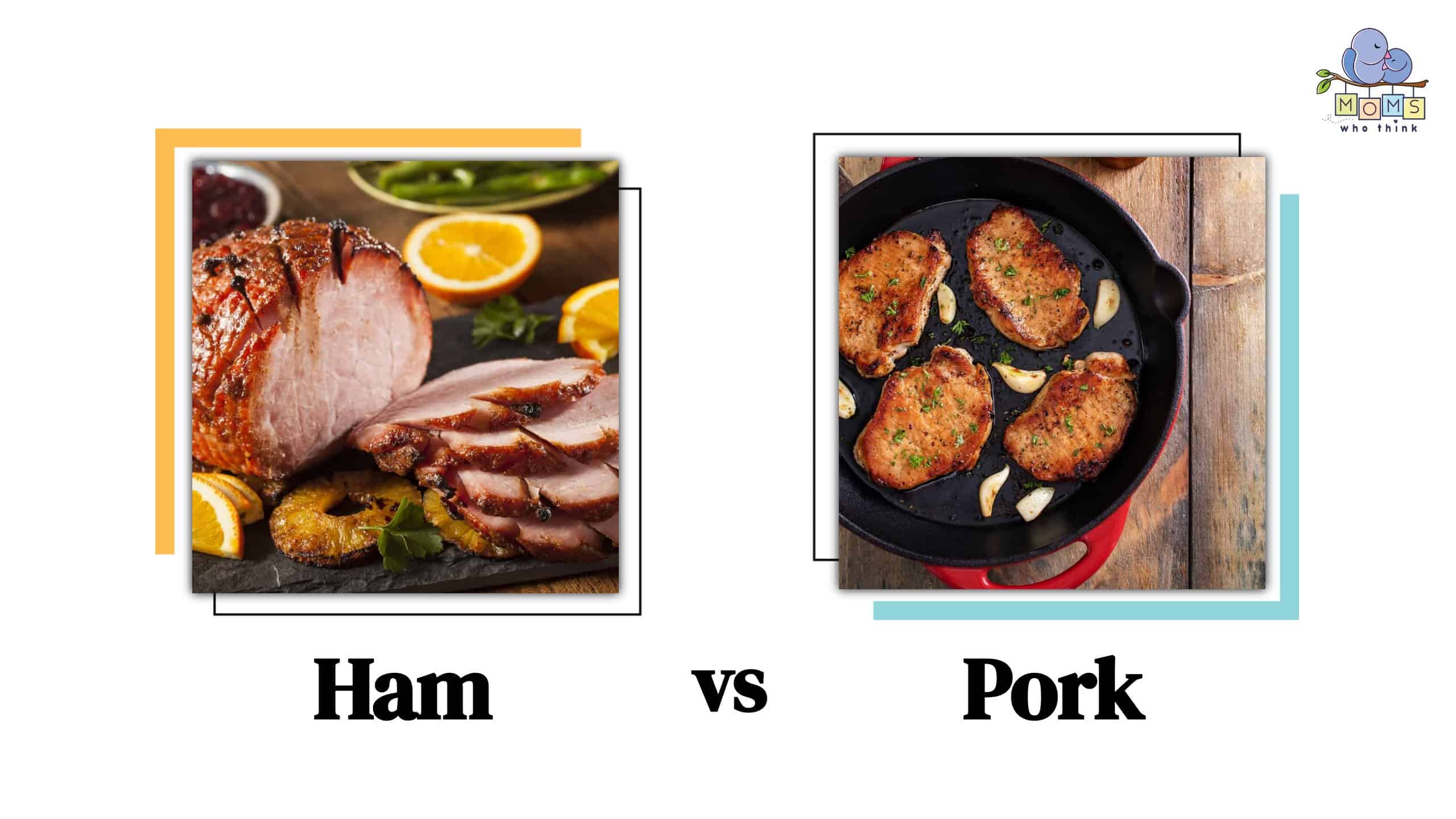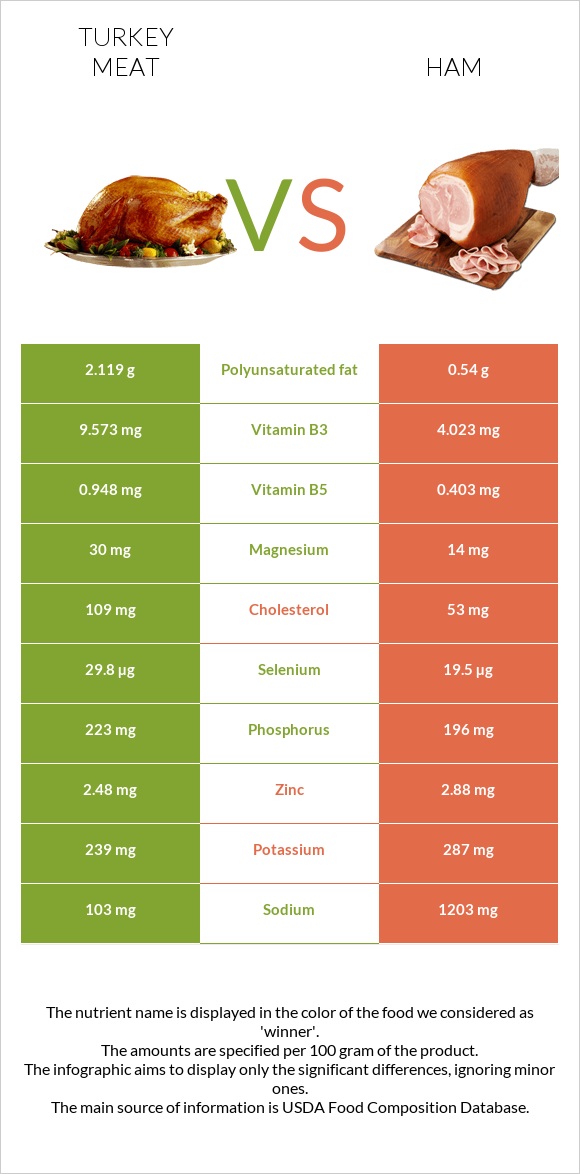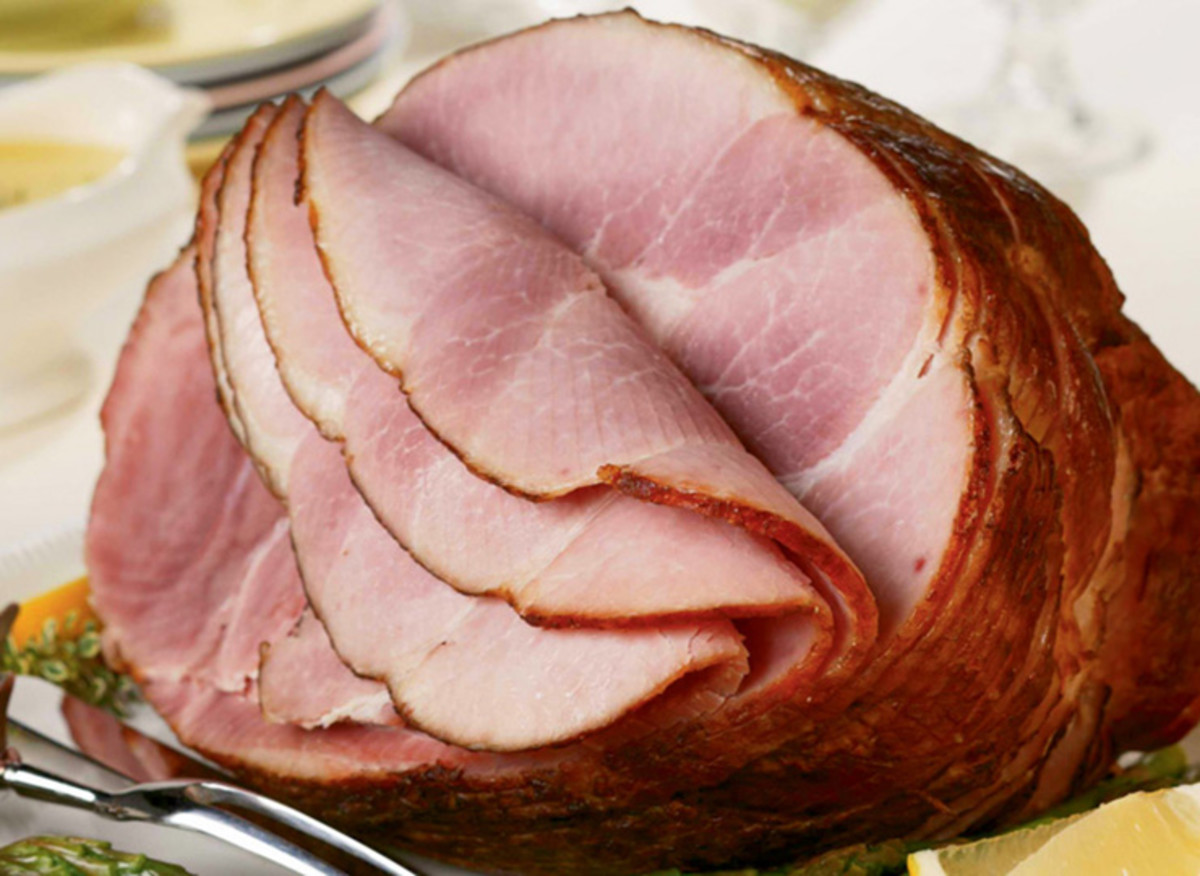The Ham And Pork Connection

The Ham and Pork Connection lies in their shared origin as meat products derived from pigs. Both ham and pork come from the same animal, but they differ in terms of preparation and cut. Ham refers to a specific cut of meat from the hind leg of a pig, while pork is a general term encompassing various cuts of meat from the pig. The connection between ham and pork is evident in their similar flavor profiles and the versatility they offer in cooking. Whether it’s a juicy ham roast or tender pork chops, these meat options provide a delightful dining experience for meat lovers.
Ham Vs Pork: Understanding The Difference
Ham and pork may come from the same animal, but they have distinct differences. Ham specifically refers to the hind leg cut of the pig, while pork encompasses various cuts from different parts of the animal. The main distinction lies in the preparation and curing process. Ham is often cured or smoked, resulting in a more intense flavor and firmer texture. On the other hand, pork can be prepared in various ways, including roasting, grilling, and frying. Understanding the difference between ham and pork is crucial when selecting the right cut for your recipes and culinary preferences.
Shared Characteristics Between Ham And Pork
Ham and pork have several shared characteristics, despite their distinct differences. They both come from the same animal, the pig, and are consumed as a source of protein. Both ham and pork are versatile and can be cooked in various ways, such as roasting, grilling, or frying. They are also commonly used in a wide range of recipes and cuisines around the world. Additionally, both ham and pork offer essential nutrients, including protein, vitamins, and minerals. However, it is important to note that the specific cuts and preparations differentiate ham from pork.
Types Of Ham

There are several types of ham available, each with its unique characteristics. Some popular types include:
- Smoked Ham: This type of ham is typically smoked over hardwood chips, giving it a distinct smoky flavor. It is often enjoyed sliced and served cold or used as an ingredient in various recipes.
- Honey-Glazed Ham: Honey-glazed ham is coated with a sweet and sticky glaze made from honey, brown sugar, and spices. The glaze adds a delicious caramelized flavor to the ham, making it a popular choice for holiday dinners.
- Spiral-Cut Ham: Spiral-cut ham is pre-sliced in a spiral pattern, which makes it easier to serve. It is often sold bone-in and can be heated and served as is or used in sandwiches and recipes.
- Country Ham: Country ham is a dry-cured ham that is typically salted and aged for a longer time. It has a strong and salty flavor and is often served thinly sliced and cooked or used as a flavoring ingredient in dishes.
- Prosciutto: Prosciutto is an Italian dry-cured ham that is thinly sliced and typically served uncooked. It has a delicate, salty flavor and is often enjoyed wrapped around fruits or used in antipasto platters.
These are just a few examples of the various types of ham available. Each type has its own unique taste and texture, allowing you to choose the one that best suits your preferences and culinary needs.
Curing Process Of Ham
The curing process is an essential step in transforming fresh pork into delicious ham. The process involves the use of curing salts, spices, herbs, and sometimes sugar to preserve the meat, enhance flavor, and prolong shelf life. The ham is typically coated in the curing mixture, which may include ingredients such as salt, sugar, and nitrites or nitrates. Then, it is left to cure in a controlled environment for a specific duration of time, allowing the flavors to develop and the meat to become more tender. The length of the curing process can vary depending on the desired flavor and texture of the ham. After curing, the ham may be smoked, cooked, or aged to further enhance its flavor profile. Overall, the curing process is a crucial step in producing the various types of ham that are available to consumers.
Varieties Of Ham Cuts
There are several varieties of ham cuts available, each offering its own unique flavor and texture. One popular cut is the ham steak, which is cured, pre-sliced, and perfect for sandwiches or salad toppings. Another option is the bone-in ham, which contains the bone and offers a richer taste. For those looking for a leaner option, there is the boneless ham, which is easy to slice and great for roasting. The spiral-cut ham is a favorite during holidays, as it is already sliced in a spiral pattern for easy serving. No matter the cut, ham offers a delicious and versatile addition to any meal.
Nutritional Value And Health Benefits

Ham is a nutritious meat that offers several health benefits. It is a good source of protein, providing the body with essential amino acids for muscle growth and repair. Ham is also rich in vitamins and minerals, including vitamin B12, zinc, and selenium. These nutrients are vital for the immune system, metabolism, and overall well-being. Additionally, ham contains healthy fats that are important for brain function and energy production. However, it is important to consume ham in moderation due to its high sodium content. Too much sodium can contribute to high blood pressure and other health issues.
Nutritional Comparison: Ham Vs Pork
When it comes to comparing the nutritional value of ham and pork, there are some key differences to consider. While both meats provide protein, ham tends to be higher in sodium content compared to pork. On the other hand, pork contains higher levels of selenium, a mineral that is important for antioxidant function and immune health. Additionally, ham is often cured, which may increase its sodium content further. It’s important to note that the nutritional profile can vary depending on the specific cut and preparation method. To make a healthier choice, opt for lean cuts of pork and consume ham in moderation to manage your sodium intake.
Health Considerations When Consuming Ham
When consuming ham, it is important to consider some health factors. Due to its curing process, ham tends to be higher in sodium content compared to other cuts of pork. Excessive sodium intake can lead to increased blood pressure and other health issues. Additionally, certain types of ham may contain added sugars or preservatives, which can negatively impact overall health. It is advisable to choose leaner cuts of ham and consume it in moderation to manage sodium intake. It is also recommended to opt for fresh or uncured ham as a healthier alternative.
Cooking With Ham And Pork

Cooking with ham and pork offers a wide range of possibilities in the kitchen. Both meats can be used in various dishes, from breakfast classics like eggs and ham to hearty stews and savory roasts. Ham is often baked or grilled and is known for its smoky, rich flavor. It can be sliced and added to sandwiches or diced and incorporated into salads or pasta dishes. Pork can be cooked in different ways, such as roasting, grilling, or pan-frying, and it can be seasoned with various spices and herbs for added flavor. Whether you’re making a comforting ham and bean soup or a tender pork tenderloin, these meats are versatile and lend themselves well to countless recipes.
Culinary Uses Of Ham
Culinary Uses of Ham: Ham is a versatile meat that can be used in a variety of dishes. It adds a smoky, savory flavor to any recipe it is incorporated into. Some popular culinary uses of ham include adding slices to sandwiches or wraps, dicing it up and adding it to salads or pasta dishes, and using it as a topping for pizzas or flatbreads. Ham can also be the star of the show in dishes like quiches, casseroles, and omelettes. Its rich flavor pairs well with ingredients like cheese, eggs, vegetables, and even fruits like pineapple. Whether it’s breakfast, lunch, or dinner, ham can easily enhance the taste of any dish.
Preparing And Serving Pork In Different Dishes
When it comes to preparing and serving pork, the possibilities are endless. Pork can be cooked in various ways, such as roasting, grilling, or braising, depending on the desired dish. For a classic roast, pork loin or tenderloin can be seasoned with herbs and spices, then cooked until tender and juicy. For a savory and comforting meal, pork chops can be breaded and pan-fried to perfection. Pulled pork is another popular option, where the meat is slow-cooked and shredded, then served with barbecue sauce. In Asian cuisine, pork is commonly used in stir-fries and noodle dishes, adding a rich and savory flavor to the recipe. Whether it’s a Sunday roast or a flavorful stir-fry, pork is a versatile meat that can be enjoyed in a variety of dishes.
Cultural Significance And Traditions

Culturally, ham has gained significant prominence and holds a special place in many culinary traditions around the world. In Western cuisine, ham is often associated with holiday feasts, such as Christmas or Easter. It is a symbol of celebration and indulgence, as families gather around the table to enjoy a succulent ham roast. In some cultures, ham is also considered a symbol of good luck and prosperity. For example, in Spain, eating 12 grapes at midnight on New Year’s Eve, along with a slice of ham, is believed to bring good fortune for the upcoming year. Similarly, in the United States, serving ham on New Year’s Day is believed to bring good luck and prosperity for the rest of the year. These cultural traditions and beliefs highlight the significance of ham in various societies and its integral role in celebratory meals.
Ham In Culinary Traditions
Ham has a rich history in culinary traditions around the world, making it a beloved ingredient in various dishes. In Western cuisine, ham is often the star of holiday feasts, being roasted and served alongside other festive dishes. It is commonly used in sandwiches, soups, and salads, adding a savory and smoky flavor. In European cuisines, ham is a staple in charcuterie boards, paired with cheeses and bread. Spanish cuisine has its iconic jamón ibérico, a cured ham that is thinly sliced and enjoyed as a delicacy. Whether it’s baked, grilled, or sliced, ham continues to be a versatile and mouthwatering ingredient in many culinary traditions.
Pork In Different Cultures
Pork holds a significant place in various culinary traditions around the world. In Chinese cuisine, pork is widely used as a versatile ingredient in dishes like char siu (barbecue pork) and sweet and sour pork. In Mexican cuisine, pork is the star of dishes like carnitas (slow-cooked, tender pork) and pozole (a hearty soup made with pork and hominy). In Filipino cuisine, lechon (roast pig) is a centerpiece in festive celebrations. In German cuisine, dishes like bratwurst and sauerkraut often feature pork as the main ingredient. The cultural significance of pork in each of these cuisines highlights its versatility and importance in different cultures.
Conclusion

In conclusion, the distinction between ham and pork lies in the specific cuts and curing process. While both ham and pork come from pigs, ham refers to the specific cut of meat from the pig’s hind leg that has undergone a curing process. Pork, on the other hand, encompasses all cuts of meat from the pig. Understanding the difference between the two allows for informed culinary choices and the appreciation of the unique flavors and textures that ham brings to dishes. Whether you’re enjoying a flavorful slice of ham or savoring the versatility of pork in various cuisines, both offer delicious options for meat lovers.
Summarizing The Distinctions Between Ham And Pork
When it comes to ham and pork, there are a few key distinctions to keep in mind. While both come from pigs, ham specifically refers to the cut of meat from the pig’s hind leg that has been cured and salted. It is usually available in a ready-to-eat form. On the other hand, pork encompasses all cuts of meat from the pig, including the shoulder, loin, and belly. Understanding these differences allows for informed culinary choices and the appreciation of the unique flavors and textures that ham brings to dishes. So, whether you’re enjoying a slice of ham or cooking with various cuts of pork, you can savor the distinct characteristics that make each one special.
FAQ About Ham Vs Pork: Unveiling The Ham Mystery
Q: What is the main difference between ham and pork?
A: The main difference is that pork is the meat that comes from the pig, while ham specifically refers to a cut of pork that comes from the pig’s hind leg.
Q: Is ham always pork?
A: Yes, ham is always pork. It is a specific type of pork that has been cured or smoked.
Q: How is ham different from other cuts of pork?
A: Ham is typically cured or smoked, giving it a distinct flavor and texture compared to other cuts of pork like bacon or pork chops.
Q: Can pork be eaten without being turned into ham?
A: Yes, pork can be consumed in various forms without being turned into ham. Pork can be roasted, grilled, or used in a variety of dishes without undergoing the curing or smoking process.
Q: Is ham healthier than other pork products?
A: The healthiness of ham versus other pork products depends on the preparation method and ingredients used. Some hams may be high in sodium and preservatives, so it’s essential to consider the nutritional content before consuming.

Johnny Knuckles Knock-out BBQ is a culinary haven for barbecue enthusiasts, offering a fusion of traditional BBQ and tantalizing street fare. Our secret to delivering mouthwatering dishes lies in our meticulous preparation process. Each cut of meat is lovingly hand-rubbed and slow-smoked over 100% hardwood, creating a symphony of flavors that will leave your taste buds dancing. Whether planning a special event or simply craving an unforgettable meal, Johnny Knuckles Knock-out BBQ is here to elevate your dining experience. Our catering services are designed to bring the sizzle and aroma of our delectable BBQ to your event, ensuring that every guest leaves with a full belly and a smile.